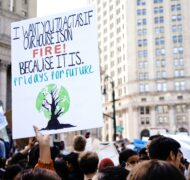Social Action
Book / Produced by partner of TOW
Hannah Arendt made a distinction between “intellectual events” and “historic events.” Often, she lamented, the two have little in common. Intellectuals toil away in the comfort of the academic peaks, while activists labor in the hurly-burly of the valley. It is essential, Arendt argued in The Life of the Mind (1971), to realize that thinking is as much a form of action as the busyness of physical activity on the streets or in the marketplace. If we ever hope to probe the deeper significance of social action, heal the present culture wars and expose the ideology and inconsistencies of political correctness, we will need to know how and when to enter the fray. We will also need to know when to step out of it and reflect on the frenetic activism within it.
The Present Complexity
Our present social mood is characterized by polarization, divisiveness and ideology. J. Hunter’s Culture Wars: The Struggle to Define America (1991) and T. Sine’s Cease Fire: Searching for Sanity in America’s Culture Wars (1995) use military metaphors to articulate a serious dilemma. The debate over whose values should win the day has fragmented our cultural ethos into all sorts of warring tribes and clans. Single-vision chiefs have bullied their way to front stage (with their obedient tribes), convinced it is their sacred duty and responsibility to win the culture war for their respective side.
If social action is ever going to be taken seriously in this environment, it must be nourished by substantive intellectual insights. This requires intellectuals and activists to work together and learn from one another. Thought and action must walk hand in hand once again. It is in this dynamic interplay that social action will take on significance.
We live in a period of intense and bitter polarization on many social issues. Political correctness and revolutionary politics exist in all sorts of crude, subtle and sophisticated ways. High and cement-packed walls often, tragically, divide and insulate groups in our society that dare to define “values,” and the need for them, in different ways.
One tribe tends to highlight traditional family values, the war on drugs, the protection of the unborn and the need for anti-euthanasia legislation. It abhors violence on our streets and in public media, and welcomes a tougher policing system, retributive justice and a return of the death penalty. This group also questions the public school system, encourages private or home schooling, challenges evolution, is opposed to homosexuality and tends, to a significant degree, to justify its position by its interpretation of the Scriptures.
Another tribe tends to highlight environmental concerns, multiculturalism, poverty and the reasons for it, aboriginal issues, feminism, human rights, animal rights and the injustice of the world order, and questions the excessive expenditure on the military. Some members accept or encourage homosexuality and defend a woman’s right to reproductive choice, including abortion; they may define the family in different ways and view justice in more of a rehabilitative and restorative way. This group also tends to be less nationalistic and more open to immigrants and refugees, to ask questions about the virtues of free trade, big business and multinational corporations, and to view racism as a disease in the marrow of our culture.
These brief sketches point to tendencies within different groups in our society. The sad thing is the way both groups often lack a rigorous sense of self-criticism. The other side is often caricatured by the use of all sorts of exclusionary language. Social psychologists call this the mote-beam syndrome. There is, in a very significant sense, the reality of excommunication for those who do not adhere to the credo of one of the groups.
The strong emotions that often animate and sustain the “values debate” need to be diffused so that serious, sensitive and public dialogue can occur between their members. Authentic dialogue begins when each group can see the beam in its own eye and be hesitant about pulling out the mote in the eye of the other, and when attentive listening begins to take place. This does not mean that agreement will necessarily occur, but such an approach creates the conditions for both groups to open their minds and chip away at the wall that divides.
Some Directions
First, it is crucial that we do not overly identify with any single cause or lobby group. One-dimensional groups frequently elevate their cause to the most important, subordinate or denigrate other social issues, then whip their devotees into an ideological frenzy. This approach to social action is problematic and, at worst, borders on the cultic. Not only is reality reduced to one issue, but the group usually insists that their interpretation of the issue is the only true one. Such a double reduction of reality is the breeding ground for fanaticism. Many of the issues raised by single-issue groups (abortion, poverty, family values, environment) are crucial and must be addressed, but each group needs the intellectual humility to recognize that theirs is not the only organization contributing to the common good! A truly pluralistic and multicultural society will respect the passions and interests of all concerned citizens.
Second, those who have the discernment to avoid single-issue lobby groups are often drawn to groups of the right or left around a cluster of issues. Just as it is questionable and intellectually naive to salute at the flagpole of single-issue groups, so it is intellectually shallow to uncritically bow before the cluster issues of the right or the left. The neoconservative worldview and the liberal worldview, like any worldview, are usually articulating important insights but doing it in a limited and prejudiced way. The obstinate fact that neoconservatives and liberals rarely turn to one another to learn from one another in a conscious and deliberate way reflects the problem. Backs are often turned on one another, and little progress is made in learning how to deal with substantive conflict and difference.
If social action is going to get out of the thickets on these issues, we desperately need visionaries who will, as a matter of principle, refuse to become ethical tribalists. Visionaries are needed who have, on the one hand, the ability to see the validity and limitations in all positions and, on the other hand, the willingness to work as bridge builders and peacemakers. The Ethics and Public Policy Center (EPPC) and the important work of the Seamless Garment Network in the USA and Canada are good as primers in this area, but the vision must go much deeper and broader. Visionaries should take their red-heat zealousness and convert it into the much hotter white heat of wisdom. When passion and wisdom come together, a new vision will occur. We still await such an integrative, inclusive, whole and indeed holy outlook and practice. When social action is informed by a thoroughly critical yet interactive outlook, the fragmentary and tribal outlook of our era will be overcome. Such individuals and communities will inevitably be misunderstood and attacked by the ideologies of all tribes. Both clarity and charity are needed.
Understanding Social Action
Social activism can mean different things. There are those who see it as the taking of one or a few issues into the streets, doing marches, vigils, demonstrations and civil disobedience. This is an important but not the only form of social activism. Some would argue that direct action is authentic education; others argue that the best form of social action is education. Social action without a well-informed input can lead to the twisting of facts and figures to suit one’s agenda. Social activism can also mean working on policy papers, presenting position papers to politicians, visiting politicians, organizing public forums for dialogue, presenting issues before the media, running for a political position (at various levels) or joining a nongovernment organization (NGO) or a government-assisted organization (GAO). Unfortunately, there is often a wide chasm between those who work at the grassroots level (and are suspicious of those in power) and those whose activism is more from an intermediate or top-down level (and are hence in positions of power).
There is a real need for all levels to begin to work together in a more responsible way rather than in a mood of cynicism and mistrust. Just as in the world of ideas we need visionaries who can integrate the best of the insights of the left and the right, so we also need organizational visionaries who are nimble enough to work at various organizational levels. Ideas need organizations and institutions to embody them in time and space. Social activists need those who think in a deep and inclusive manner; they also need people who can administrate, organize and carry the ideas institutionally over time. Unfortunately, many extreme idealists are so skeptical of organizations that they negate the very thing that could carry their vision. The church, too, can become a self-serving and bureaucratic institution, but it can also be the vehicle for visionary social change. When the visionary turns against the church in the name of a purist idealism, animosity occurs and the vision of the visionary loses the opportunity to take substantive material form. But when vision and institution constantly, like sandpaper, rub against one another, much more is accomplished. This is not the easy way; it is simpler for visionaries and idealistic communities to head off in one direction and institutions to lumber along in another. But vision and institution need not hike in opposite directions. It is when they walk together that substantive social action can be affected.
Finally, we must exercise prophetic discernment. Arendt’s The Human Condition (1958), Charles Taylor’s The Malaise of Modernity (1991), Jean Bethke Elshtain’s Democracy on Trial (1993) and James Skillen’s Recharging the American Experiment: Principled Pluralism for Genuine Civic Community (1994) each highlight, in their different ways, the need for space to be provided in which substantive areas of disagreement and conflict can be heard and struggled through. Such insistence and passionate pleas by centrist and various types of communitarian liberals must be heard and acted upon if we are not going to create a society of ideological ghettos. But there are also limitations to this approach.
The ominous misuse of power is often camouflaged by seductive language and interest groups. This, then, is the dilemma of many social activists. When this directs the social and political scene, how can the “power elites” be challenged? In short, there are limits to dialogue in the search for change. When the Other refuses to listen, when unequal relationships and class structures are firmly maintained, when tyrants burst with “egophanic” fullness, the call for dialogue falls on deaf ears. The quest to dominate, control and manipulate by “power elites” such as corporations, the military-industrial complex, state bureaucracies and various liberationist groups presents a serious challenge. We need to ask ourselves, constantly, about those who have concentrations of power and wield it in an unjust way. We often go after the minnows but stroke the backs of sharks. The task of the intellectual activists is to know when the limits of dialogue and civility have been reached, and when prudence would move us from thought and dialogue to some form of responsible social protest.
Historically, the church was distinguished by its service to society. Areas in which the church undertook practical neighbor-love include the care of infants and children, hospitality, the burial of the dead during plagues, the care of widows and orphans, the status of women and the establishment of hospitals and universities. Besides being the chief civilizing agency during the Middle Ages, the church was the chief instrument of social justice. During the revivals of the eighteenth and nineteenth centuries, the evangelists were often the leaders of social reform. Wesley said, “The Gospel of Christ Jesus knows . . . no holiness, but social holiness.” In The Social Achievements of the Christian Church E. H. Oliver says the church has a fivefold function as servant: it must educate and inspire; it must pioneer new ministries; it must study to prevent rather than to cure; it must transform the helped into helpers. But the fifth is the function so desperately needed today: it must exercise its age-long prophetic vocation and serve as conscience to society (Oliver, p. 116).
» See also: Citizenship
» See also: Civil Disobedience
» See also: Mission
» See also: Multiculturalism
» See also: Politics
» See also: Voting
References and Resources
H. Arendt, The Human Condition (New York: Harcourt Brace Jovanovich, 1978); H. Arendt, Life of the Mind (Chicago: University of Chicago Press, 1958); R. Beiner, What’s the Matter with Liberalism? (Berkeley: University of California Press, 1992); N. Chomsky, Deterring Democracy (New York: Verso, 1991); N. Chomsky, Necessary Illusions (Montreal: CBC Enterprises, 1989); H. G. Gadamer, Truth and Method (New York: Continuum, 1975); J. Habermas, Autonomy and Solidarity (London: Verso, 1992); A. MacIntyre, After Virtue (Notre Dame, Ind.: University of Notre Dame Press, 1984); A. MacIntyre, Whose Justice, Which Rationality? (Notre Dame, Ind.: University of Notre Dame Press, 1988); E. H. Oliver, The Social Achievements of the Christian Church (United Church of Canada, 1930); E. Said, Culture and Imperialism (New York: Knopf, 1993); C. Taylor, The Ethics of Authenticity (Cambridge, Mass.: Harvard University Press, 1992; published in Canada as The Malaise of Modernity, 1991); D. Walsh, After Ideology: Recovering the Spiritual Foundations of Freedom (San Francisco: Harper & Row, 1990); S. Weil, The Need for Roots (New York: Harper & Row, 1971).
—Ron Dart





